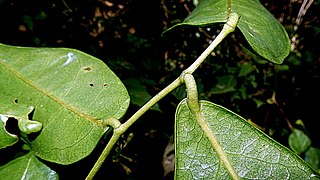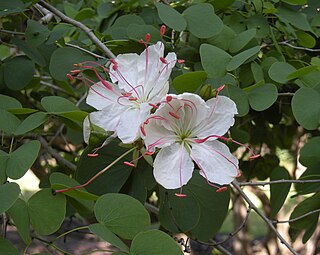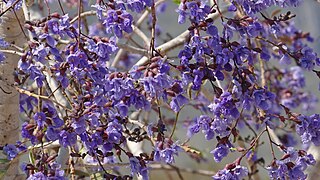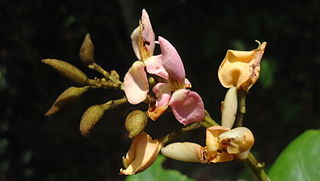
The Faboideae are a subfamily of the flowering plant family Fabaceae or Leguminosae. An acceptable alternative name for the subfamily is Papilionoideae, or Papilionaceae when this group of plants is treated as a family.

Zornia is a cosmopolitan genus of herbs from the legume family Fabaceae. It was recently assigned to the informal monophyletic Adesmia clade of the Dalbergieae.

Acosmium is a South America genus of flowering plants in the family Fabaceae. Three species are currently recognized. Most Acosmium species have been recently transferred to Leptolobium and one species to the South American Guianodendron while the genus Acosmium itself has been transferred from the tribe Sophoreae to the tribe Dalbergieae in a monophyletic clade informally known as the Pterocarpus clade.

Diplotropis is a genus of trees. It includes ten species native to northern South America, ranging from Colombia and Venezuela to Bolivia and west-central and southeastern Brazil.
Orphanodendron is a genus of legume in the legume family, Fabaceae. It includes two species of trees native to Colombia, which grow in tropical lowland forest. The genus is in subfamily Faboideae.

Poecilanthe is a genus of flowering plants in the family Fabaceae. It includes 9 species of trees and shrubs native to eastern, southern, and west-central Brazil, Bolivia, Paraguay, Uruguay, and northeastern Argentina. They grow in seasonally-dry tropical forest, woodland, thicket, and riverine forest.

Crotalarieae is a tribe of flowering plants belonging to the family Fabaceae. It includes rooibos (Aspalathus linearis), which is harvested for sale as a tisane.

Leptolobium is a small Neotropical genus of plants in the family Fabaceae, with 12 species currently recognized. With the exception of Leptolobium panamense, which occurs in tropical forests from northwestern South America to Mexico, all species of Leptolobium are restricted to South America and most diverse in Brazil. Most Leptolobium species have been traditionally included in AcosmiumSchott (Fabaceae), but both genera have been recently distinguished based on several vegetative and reproductive traits.

Lysiphyllum is a genus of flowering plants in the legume family, Fabaceae. It includes nine species of trees, semi-scandent shrubs, and lianas which range from India through Southeast Asia to Australasia. Typical habitats include seasonally-dry tropical forest and woodland, vine thickets, Brigalow and Gidgee scrubland, floodplains, alluvial flats, tidal forest, mangroves, river and stream banks, and occasionally dunes and coral islets. They can grow on diverse soils including calcareous, granitic, and basaltic.

Piliostigma is a genus of flowering plants in the legume family, Fabaceae. It includes five species of small deciduous trees native to sub-Saharan Africa, the Indian subcontinent, Indochina, Java, the Philippines, and northern Australia. It belongs to the subfamily Cercidoideae and the tribe Bauhinieae. It is dioecious, with male and female flowers on separate plants.

Muellera is a genus of flowering plants in the family Fabaceae. It includes 32 species native to the tropical Americas, ranging from southern Mexico to northern Argentina. It belongs to the subfamily Faboideae.

Bocoa is a genus of flowering plants in the legume family, Fabaceae (Leguminosae). It belongs to the subfamily Faboideae (Papilionoideae). Several species in the genus were recently reclassified as Trischidium.

Bowdichia is a genus of flowering plants in the legume family, Fabaceae. It belongs to the subfamily Faboideae. The genus includes two species native to tropical South America and Costa Rica.

The tribe Brongniartieae is one of the subdivisions of the plant family Fabaceae, primarily found in tropical regions of the Americas and in Australia The members of this tribe consistently form a monophyletic clade in molecular phylogenetic analyses. The tribe does not currently have a node-based definition, but morphological synapomorphies have been identified:
"stamens united by filaments in an adaxially open tube; anthers alternately long and basifixed, short and versatile; anther connective inconspicuous; septa present between seeds in pods; aril lateral lobe present and fitting into heel of funicle; fine red glandular processes present in axils; and pollen tricolporate with opercula and no definite endoaperture."

The tribe Dalbergieae is an early-branching clade within the flowering plant subfamily Faboideae. Within that subfamily, it belongs to an unranked clade called the dalbergioids. It was recently revised to include many genera formerly placed in tribes Adesmieae and Aeschynomeneae and to be included in a monophyletic group informally known as the dalbergioids sensu lato. The members of this tribe have a distinctive root nodule morphology, often referred to as an "aeschynomenoid" or "dalbergioid" nodule.

The tribe Podalyrieae is one of the subdivisions of the plant family Fabaceae.

Leptolobieae is a Neotropical, early-branching monophyletic clade of the flowering plant subfamily Faboideae or Papilionaceae that are mostly found in South America.
Staminodianthus is a genus of trees found in South America. It includes three species of trees, from small trees to six meters tall to large trees up to 40 m tall. They are native to the Amazon Basin of northern Brazil, Colombia, Guyana, Peru, and Venezuela, where they grow in humid non-flooded terra-firme forests on sandy or sandy loam soils, gallery forests, and highland savannas.

The tribe Exostyleae is an early-branching monophyletic clade of the flowering plant subfamily Faboideae that are mostly found in Neotropical rainforests.

Limadendron is a genus of small trees in the family Fabaceae. It includes two species native to northern South America, including Colombia, Venezuela, the Guianas, northern Brazil, and Peru. The genus was recently separated from the genus Poecilanthe. It belongs to the tribe Brongniartieae.
















